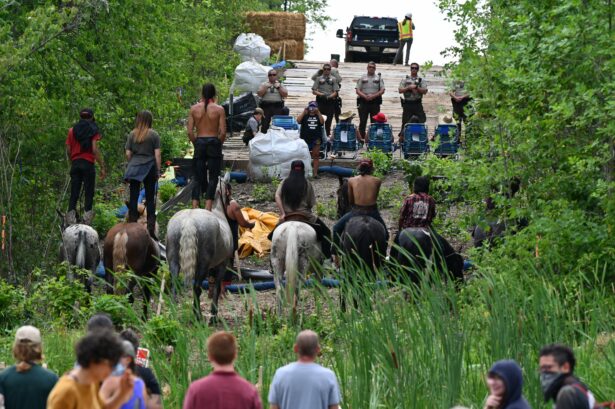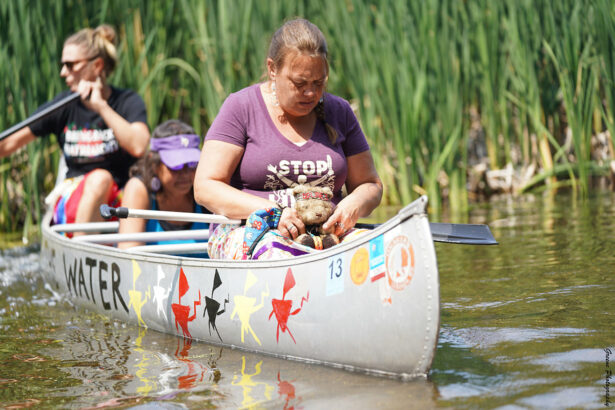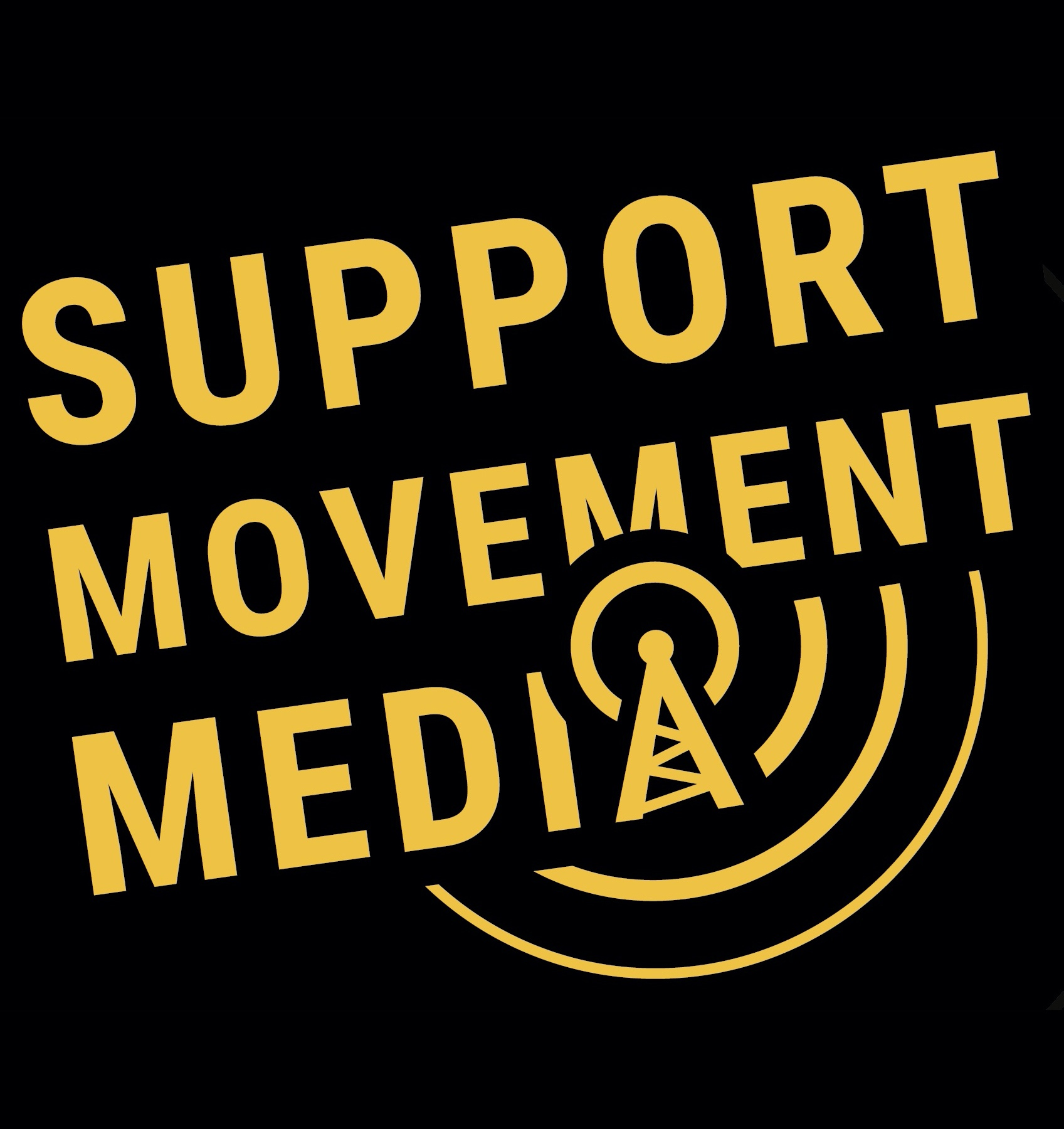On Monday, July 19, in a red shirt and long black skirt, Sasha Beaulieu strode toward the Middle River in northwestern Minnesota to fulfill her official role as the Red Lake Nation Tribal Monitor. The water was incredibly low from the drought, and in parts the river bed was completely dry — all of which she would report to the Army Corps of Engineers with the hope of stopping the Canadian corporation Enbridge from drilling under Middle River to install the controversial Line 3 pipeline. Enbridge had already polluted the Willow River while trying to install the pipeline, an accident discovered by water protectors and reported to regulators. Beaulieu explained on Facebook Live that the company is supposed to stop pumping water when the river level is below a foot and a half, but Enbridge was not complying.
As Beaulieu recorded her findings, 40 people from the Red Lake Treaty Camp took up positions on the bridge, chanting and holding signs, the largest of which said, “Honor the Old Crossing Treaty of 1863,” which gives people of the Red Lake Nation the right to sustain themselves through fishing on the region’s rivers, as well as hunting and performing ceremony there. Meanwhile, at the Shell River, two hours to the southeast, a different tactic was being deployed, as famed Indigenous rights activist Winona LaDuke and six other elder women sat in lawn chairs, blocking Enbridge construction in defiant civil disobedience.
Previous Coverage
 What role were you born to play in social change?
What role were you born to play in social change?When sociologist Bill Moyer studied successful social change movements, he found that four roles showed up over and over again: helpers, advocates, organizers and rebels — labels coined with Moyer’s permission by veteran activist trainer and Waging Nonviolence columnist George Lakey. One of the things that struck me during 10 days in northern Minnesota was how the campaign to stop Enbridge’s Line 3 pipeline has effectively engaged all four roles, often simultaneously.
When Enbridge filed a notice plan with the Minnesota Public Utility Commission, or MPUC, in late 2014, Anishinaabe leaders took on the advocate role, using the tools of the system to try to stop the pipeline intended to transport tar sands oil across Minnesota and Wisconsin. They showed up to hearings and recruited others to testify, as well. Testifiers talked about the environmental impact the pipeline would have on a region with so much fresh water, especially the 22 rivers the pipeline would cross. They talked about the climate impact of burning tar sands oil. They talked about treaty rights. They talked about Enbridge’s abysmal safety record. Sixty-eight thousand people submitted testimony — 94 percent were against the pipeline, while Enbridge bused in workers to speak in support. When the MPUC approved the pipeline anyway in June 2018, Anishinaabe leaders vowed to keep fighting, still using advocacy tactics — appealing to courts, politicians and regulators, like the Army Corps, as Sasha Beaulieu did — while also ramping up their rebel action.
Unlike advocates, rebels shake up business as usual, interrupting injustice directly and challenging corrupt systems by refusing to play by their rules. Civil disobedience is a classic tactic, one that has been used effectively in the Line 3 fight to both bring attention to the situation and to actually delay pipeline construction by hours or days, especially at river crossings. Of the 600 arrests so far, some were for simply trespassing on Enbridge construction sites, while other people locked down to Enbridge equipment or even climbed inside pipes. Many actions have involved prayer, which plays an important role in this Indigenous-led campaign. Six hundred arrests is impressive. The 2016-2017 height of the struggle at Standing Rock to stop the Dakota Access pipeline involved only 800 total arrests, out of the 10,000 people who camped there, a significantly higher number than have joined the camps opposing Line 3. That suggests that a higher percentage of Line 3 water protectors are engaging in rebel action.
Previous Coverage
 Indigenous-led resistance to Enbridge’s Line 3 pipeline threatens Big Oil’s last stand
Indigenous-led resistance to Enbridge’s Line 3 pipeline threatens Big Oil’s last standRebel action is particularly effective at revealing what is wrong with the system. In counties across northern Minnesota, the police show up to defend a Canadian corporation that is breaking the law instead of defending treaty rights, which are protected in the U.S. Constitution. As direct action has increased this summer, so too has police repression. On June 28, Hubbard County police blocked one camp from exiting their own driveway, which they were eventually ordered to stop. A few hours away, in Pennington County a member of the Red Lake Treaty Camp was arrested and held for a few days. According to his account, he was simply scouting Enbridge construction sites with a drone, but Enbridge workers falsely claimed that he tried to hit them with his car. After the Enbridge drill arrived at the Red Lake River, site of the Red Lake Treaty Camp, police allegedly pushed people to the ground, arrested 22 during a spiritual ceremony and kept a heavy presence around the camp. After the water protectors were released two days later, the police grabbed and detained a young member of the Red Lake Nation as he was coming out of the gas station bathroom. Two other water protectors were arrested while demanding to know on what grounds their friend was being detained.
Such incidents vividly illustrate the unjust treatment of Indigenous people and the fact that institutions meant to protect the public are deployed to protect a foreign multinational. At Standing Rock, and in many other justice campaigns, such repression actually helps to build sympathy for the movement and inspire others to come, especially once the media start covering it.
While rebels bring heat and pressure to a campaign, organizers also bring in more people, which is essential. Throughout the Stop Line 3 fight, some events have been geared for mass appeal with celebrities, like Jane Fonda, as well as food and music. At the Treaty People’s Gathering in early July — which emphasized that all citizens of the United States were bound by the treaties signed by their government — well over 2,000 people gathered along the upper Mississippi River. While most participated in a simple march, a smaller group willing to do direct action filed off to occupy the river bank where the pipeline would be submerged. They held the space in a round-the-clock vigil for eight days. Meanwhile, many of the marchers went home and shared how moved they were by the experience on social media and in blog posts.

Less than two weeks later on July 15, 300 people gathered for the Women for the Rivers event at the Shell City Campground on the banks of the Shell River. Actress Marisa Tomei, playwright V (formerly known as Eve Ensler), and Sierra Club head Mike Brune were featured speakers, though the Indigenous youth and women upstaged them with passionate accounts of the struggle so far. A charter bus from Minneapolis enabled people to participate who weren’t ready or able to spend days or weeks at a camp. Many others, including myself, traveled from different camps, giving us the feeling of being part of a large campaign, which is sometimes difficult with camps spanning over 200 miles, a situation very different from Standing Rock.
The Women for the Rivers action component was low risk. Amid drumming and prayers, many people danced in the shallow Shell River, as a smaller number of rebels staked out space on the Enbridge easements, a temporary wooden road installed on each bank, where the pipeline was slated to be installed. With Enbridge workers absent that day, the police did not arrest them, and everyone returned to camp for a large meal, including grilled corn, fresh fish and salad. A few days later, on July 19 on the same easement, LaDuke — a member of the local White Earth Nation — led the civil disobedience action in lawn chairs with six other elder women, flanked by water protectors on horseback. In hindsight, the large gathering a few days earlier had both been a movement expander and a trial run for the rebels.
Helpers are integral to all of this. Feeding thousands is obviously a lot of work, but so is the day-to-day chore of feeding the ongoing camps. While everyone participates in chores, from washing dishes to cleaning the pit latrines, there are some people who have made these types of services their primary contribution to the campaign. While they get less attention on social media than the rebels, their work is invaluable, like the women who cooked for all those church meetings during the civil rights movement, and those who drove bus boycotters to work every day for over a year in Montgomery. In the Line 3 campaign, helpers are also raising money for bail — which has sky-rocketed in the last month — as well as making banners and other tasks that support the movement without directly challenging or appealing to decision-makers.

After 10 days camping at Red Lake Treaty Camp, I was hugging people goodbye as the drill arrived at the Enbridge site next door. That meant that the Red Lake River — itself low and lined with the shells of clams killed from the heat — would be next for drilling. I stayed long enough to offer a nonviolent direct action training, but decided to keep my plans of returning home to Philadelphia, knowing there was much I could do from there to support the camp.
I started calling friends from the security line of the Minneapolis airport to see if anyone would do civil disobedience with me two days later in Philadelphia. By the time I boarded the plane, I had a skeletal crew, predominantly members of Earth Quaker Action Team, or EQAT, who jumped in to organize jail support, create a Facebook event and do outreach to other groups concerned with Line 3.
In less than 48 hours, we pulled off an action at a center city TD Bank, chosen for its role in financing Line 3. Out of 28 participants, seven risked arrest, sharing their concerns about climate change and treaty rights over social media when the Philadelphia police chose not to arrest us, even after we blocked traffic. Our solidarity action turned out to be the same morning that seven water protectors at Red Lake Treaty Camp were arrested.

Support Us
Waging Nonviolence depends on reader support. Become a sustaining monthly donor today!
DonateEvery Facebook post from the camp encouraged my commitment to do more. I donated money for my friends’ bail, organized others to do the same and encouraged people to call President Biden. I pitched local media and invited my newsletter list to hear about my trip during a Zoom session, which attracted 50 people. Although I’m not accustomed to playing all of the Four Roles of Social Change at once, I realized that each was available to me as an ally, giving me more opportunities to help from afar.
In most movements, both organizations and individuals tend to specialize where they feel they will be most effective, often with competition between those playing the different roles. Although the Stop Line 3 campaign is unlikely to be immune from such tensions, what I witnessed was far more harmony than competition, something not every campaign is wise enough to achieve. I suspect the leadership of Indigenous women plays a key role here with their emphasis on community over individualism. Over and over I heard them encourage allies to come “in a good way,” bringing the gifts they have to offer while recognizing that they are a small part of a greater whole. This is exactly the attitude needed to build a movement strong enough to beat a company as powerful as Enbridge.

It is inspiring to hear these tales of courage. All love surround those standing firm against the Line 3 pipeline. Thank you for this report from the front lines.
Thank you for the quick turnaround from camp to action to writing and talking about all of it. I felt the urgency through your energy (and tears). I can be a helper. I read about the last action on FB. Is that still the best place to keep in touch?
Good morning. I did a ceremony when the horse riders was arrested.
I remember last winter an out of State Enbridge worker went in to a ditch, he was driving too fast. Water Protectors concerned about his well-being offered to help get his truck out of the ditch, he refused.
In two different counties in northern Minnesota, Enbridge employees were arrested for human sex trafficking.
The battle isn’t over yet. Water is life, literally!
Miigwech, Anita
Thank you for this comprehensive overview of all the work being done to stop Line 3. One small correction. The Treaty People Gathering was in early June, not July.
God bless you, Eileen.